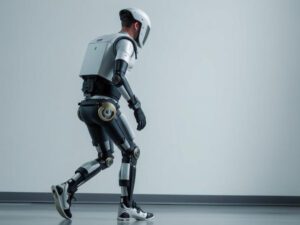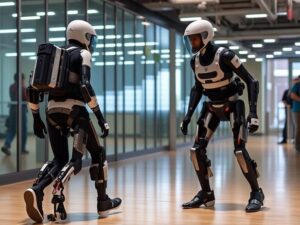Exoskeletons are robotic bodysuits that augment human strength, stamina, and movement. They achieve this by transferring power and assistance from the outside, enabling users to perform tasks that would otherwise be impossible or extremely difficult. Essentially, it’s a robot bodysuit working in concert with your body.
Exoskeletons for Providing Mobility
Exoskeletons used for providing mobility generally fall into two categories:
Powered Exoskeletons
These have active mobility motors, providing walking, standing, and lifting capabilities. They are primarily used by individuals with spinal cord injuries or other mobility disorders.
Passive Exoskeletons
These provide stabilization and support, assisting with strain relief and posture optimization. They are often used by patients with back or other musculoskeletal conditions.

Impact of Exoskeletons on Mobility Devices
Exoskeletons offer numerous advantages for mobility:
- Mobility Aiding: Exoskeletons can enable paralyzed or impaired individuals to walk and perform daily activities.
- Increased Autonomy: They can increase independence for users and reduce the burden on caregivers.
- Less Strain and Pain: Stabilizing exoskeletons can immobilize and stabilize joints and muscles, reducing strain and pain.
- Increased Rehabilitation: Exoskeletons can be used in rehabilitation to help patients regain mobility and strength after surgery or trauma.
- Improved Quality of Life: Increased mobility and independence contribute to a better quality of life.

Examples of Exoskeleton Use
- Rehabilitation Clinics: Many rehabilitation clinics now use exoskeletons to support patients recovering from stroke or spinal cord injuries.
- Home Use: Exoskeletons are increasingly used at home to assist with mobility and independence.
- Workplace: Exoskeletons are being implemented in some workplaces to prevent injuries and maximize worker productivity.
The Future of Exoskeletons
The future of exoskeletons is promising. Technological advancements are making them lighter, cheaper, and more comfortable. Scientists are even working on developing mind-controlled exoskeletons for easier patient use.
Exoskeletons, wearable robotic systems that enhance human strength, endurance, and mobility, are rapidly evolving and finding applications in various fields. The future of exoskeleton technology is promising, with advancements in materials, AI integration, and improved power sources driving innovation.
Exoskeleton technology is rapidly advancing, revolutionizing industries such as healthcare, manufacturing, and defense. These wearable robotic systems are designed to enhance human strength, endurance, and mobility, offering new possibilities for individuals with physical disabilities, workers in physically demanding jobs, and soldiers in high-risk environments.
In the medical field, exoskeletons are proving to be life-changing for individuals with spinal cord injuries, stroke recovery patients, and those with neuromuscular disorders. As AI and sensor technology improve, these devices are becoming more adaptive, allowing for personalized movement assistance and rehabilitation. Future advancements will focus on making exoskeletons lighter, more efficient, and accessible to a broader population

Challenges and Considerations
Despite their potential, there are challenges to consider:
- Cost: Exoskeletons are currently expensive, limiting accessibility. However, costs are decreasing.
- Weight and Size: Exoskeletons can be bulky and heavy, restricting use in certain environments. Smaller versions are being developed to address this.
- Usability: Learning to use an exoskeleton requires practice and adaptation. Companies are working to make them easier to use.
- Affordability: The cost of training and becoming proficient with an exoskeleton can be significant.
Assistance Programs and Resources
Affording an exoskeleton can be challenging. Consider exploring these options:
- Insurance: Insurance may cover the cost if the exoskeleton is medically necessary.
- Government Programs: Contact state or federal agencies to inquire about programs that cover assistive technology.
- Non-profit Organizations: Some non-profit organizations provide grants or assistance for people with disabilities.
The Societal Contribution of Exoskeletons
Exoskeletons can contribute to a healthier society by:
- Extending the active lives of disabled individuals.
- Reducing medical costs associated with inactivity and secondary diseases.
- Creating new jobs in exoskeleton R&D, manufacturing, and training.


Exoskeletons, or wearable robots, represent a significant advancement in mobility assistance technology. They offer hope for the elderly and disabled, empowering them to lead more mobile and active lives. As technology continues to evolve and become more accessible, exoskeletons will play an increasingly important role in providing support and enhancing quality of life.







































Leave a Review